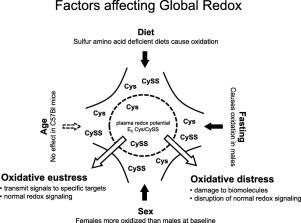The Journal of Nutritional Biochemistry ( IF 4.8 ) Pub Date : 2020-05-24 , DOI: 10.1016/j.jnutbio.2020.108431 Walter H Watson 1 , John C Greenwell 2 , Yuxuan Zheng 2 , Stephen Furmanek 3 , Edilson Torres-Gonzalez 4 , Jeffrey D Ritzenthaler 4 , Jesse Roman 4

|
Age, sex and diet are well-established risk factors for several diseases. In humans, each of these variables has been linked to differences in plasma redox potentials (Eh) of the glutathione/glutathione disulfide (GSH/GSSG) and cysteine/cystine (Cys/CySS) redox couples. Mice have been very useful for modeling human disease processes, but it is unknown if age, sex and diet affect redox couples in mice as they do in humans. The purpose of the present study was to examine the effects of these factors on plasma redox potentials in C57BL/6J mice. We found that age had no effect on either redox couple in either sex. Plasma Eh Cys/CySS and Eh GSH/GSSG were both more oxidized (more positive) in females than in males. A 24-hour fast negated the sex differences in both redox potentials by oxidizing both redox couples in male mice, while having no effect on Eh Cys/CySS and a smaller effect on Eh GSH/GSSG in female mice. A diet with excess sulfur amino acids reduced the plasma Eh Cys/CySS in females to a level comparable to that seen in male mice. Thus, sex-specific differences in plasma Eh Cys/CySS could be normalized by two different dietary interventions. Some of these findings are consistent with reported human studies, while others are not. Most strikingly, mice do not exhibit age-dependent oxidation of plasma redox potentials. Care must be taken when designing and interpreting mouse studies to investigate redox regulation in humans.
中文翻译:

性别,年龄和饮食对小鼠半胱氨酸/胱氨酸和谷胱甘肽/谷胱甘肽二硫化物血浆氧化还原对的影响。
年龄,性别和饮食是几种疾病的公认危险因素。在人类中,这些变量中的每一个都与谷胱甘肽/谷胱甘肽二硫化物(GSH / GSSG)和半胱氨酸/胱氨酸(Cys / CySS)氧化还原对的血浆氧化还原电势(E h)的差异有关。小鼠在模拟人类疾病过程中非常有用,但尚不清楚年龄,性别和饮食是否像人类一样影响小鼠中的氧化还原对。本研究的目的是研究这些因素对C57BL / 6J小鼠血浆氧化还原电位的影响。我们发现,年龄对男女的氧化还原夫妇没有影响。血浆E h Cys / CySS和E h女性体内的GSH / GSSG氧化程度均高于男性(更阳性)。通过氧化雄性小鼠中的两个氧化还原对,24小时禁食可消除两种氧化还原电位的性别差异,而对E h Cys / CySS没有影响,而对雌性小鼠E h GSH / GSSG的影响较小。含过量硫氨基酸的饮食可使雌性的血浆E h Cys / CySS降低至与雄性小鼠相当的水平。因此,血浆E h的性别特异性差异可以通过两种不同的饮食干预使Cys / CySS正常化。这些发现中的一些与已报道的人类研究一致,而另一些则与之不同。最惊人的是,小鼠没有表现出年龄依赖性的血浆氧化还原电势氧化。在设计和解释小鼠研究以研究人类中的氧化还原调节时,必须小心谨慎。










































 京公网安备 11010802027423号
京公网安备 11010802027423号